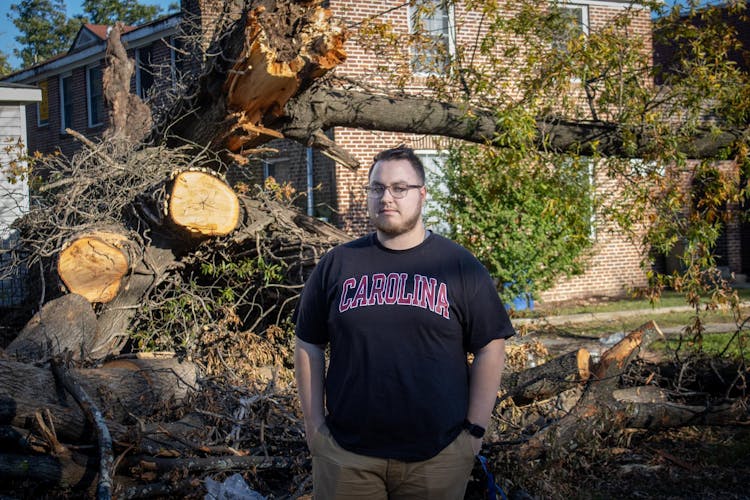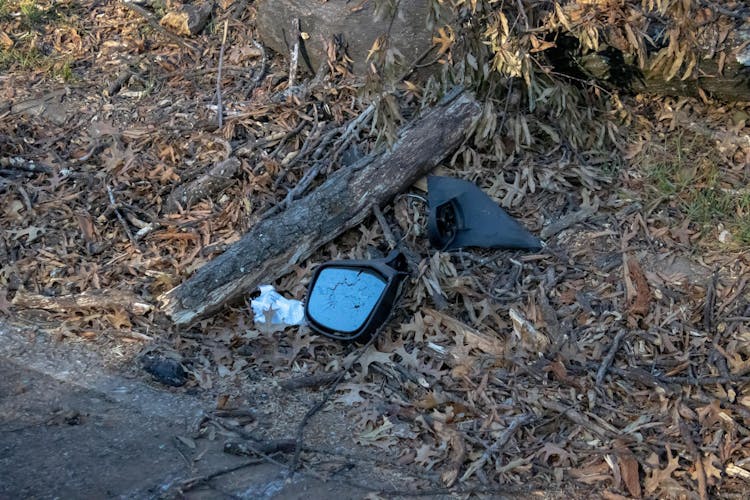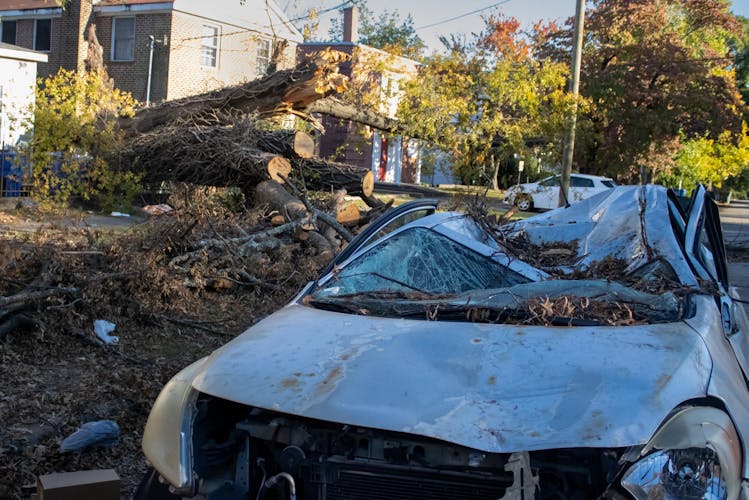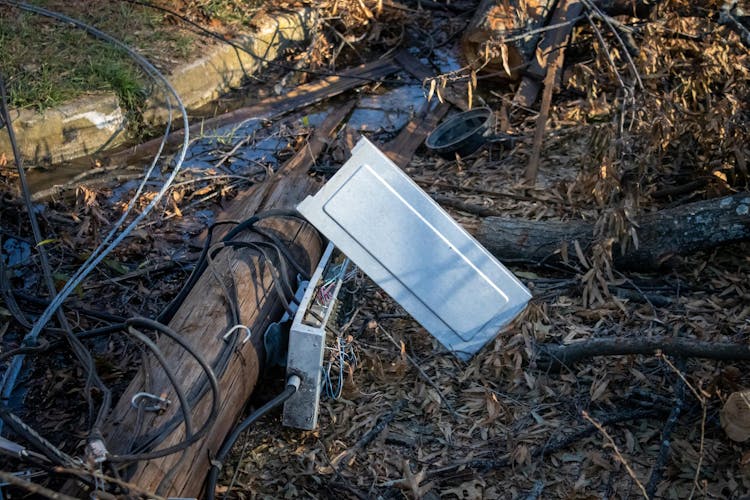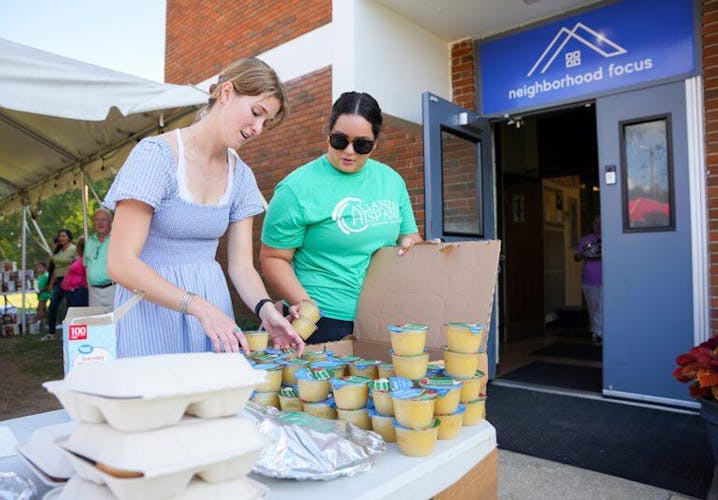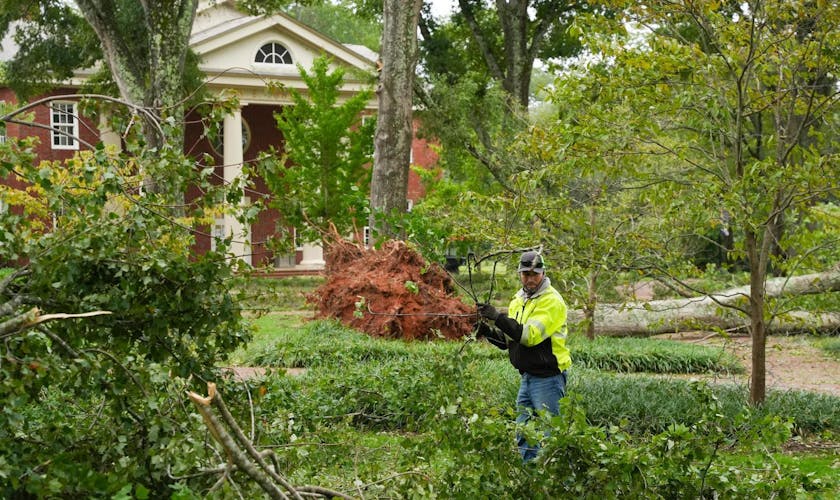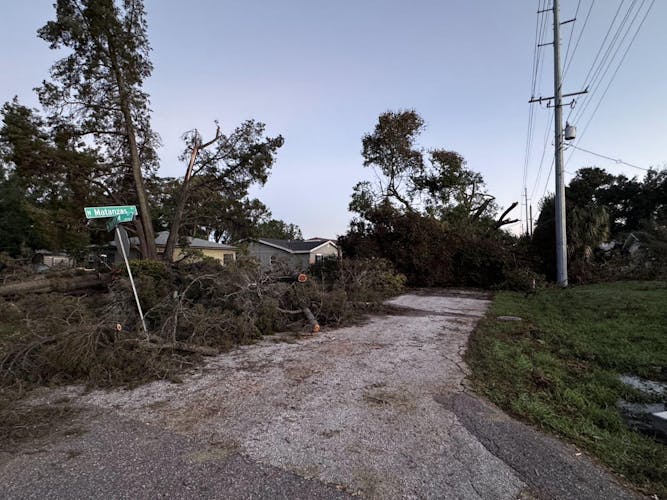Editor’s note: This article was written in collaboration between The Daily Gamecock, The Paladin and The Minaret. Franchesca Murrugarra is a reporter with The Minaret, and Carter Ozburn and Walker Smith are reporters with The Paladin.
USC student Matthew Snyder lived without power for two weeks after Hurricane Helene knocked out electricity to more than 190,000 homes in Richland County on Sept. 27.
That morning Snyder, who is in the graduate sport and entertainment management program, was startled by what he thought was a thunderstorm.
“Around 5 a.m., I saw a blue flash and a big thud, and I thought, 'Oh crap, here comes a thunderstorm,'” he said. “So I was like, all right, just hunker down. Power went immediately off, because I usually have the TV on when I sleep. So I knew exactly when the TV went off, power went off.”
Once Helene had passed, Snyder said he looked outside and saw a large oak tree had fallen on the street, taking a number of wires and cables with it, he said. Two cars were left shattered underneath the tree, and it would be six days before the oak was moved.
Hurricanes Helene and Milton brought historic levels of destruction on the Southeast. Deadly floods occurred in North Carolina, widespread power outages ranged from Florida to Tennessee and high winds damaged or destroyed homes.
The Daily Gamecock collaborated with The Paladin and The Minaret to talk to students, like Snyder, across the Southeast who have been dealing with the hurricanes’ impacts months later.
Several climate, hurricane and environmental experts across the region told The Daily Gamecock the storms brought on by the 2024 hurricane season were likely influenced by changes in the world’s climate and continued warming may worsen their effects.
A busy hurricane season
The week immediately following Hurricane Helene came with its own whirlwind of activity, with students rushing back to Tampa, Florida, to the University of Tampa’s campus, settling in, checking new due dates for assignments and watching as the news poured in by the hour, reporting the storm’s widespread devastation that crossed state lines.
For Jaden Workman — an ROTC cadet majoring in applied sociology and triple minoring in leadership studies, military science and criminology — that week was her time to recover and catch up on schoolwork.
“I had classes — makeup classes — and I had tattoo appointments,” said Workman, with an amused smile on her face. “I was just in work mode that whole week because we had tons of work to make up from Helene.”
Things started to return back to normal for Workman, until Oct. 5 when news of another storm system forming in the Gulf of Mexico came along. The warning of another major hurricane, coming less than 10 days after Hurricane Helene, hit loomed over a wearied Florida.
Nicholas Grondin, an assistant professor of environmental studies at the University of Tampa, was also forced to evacuate to Daytona Beach as Hurricane Milton approached. Helene and Milton, he said, were unusual storms that were exacerbated by climate change.
“The rainfall associated with Helene was almost certainly made worse by a changing climate, likely human caused, because a warmer atmosphere can hold more water vapor,” Grondin said. “And at the rate we're warming — we haven't seen this level of warming — and it correlates perfectly with greenhouse gas emissions.”
Greenhouse gas emissions are human produced gasses that trap heat in the atmosphere, leading to global climate change, according to The Environmental Protection Agency.
The rainfall from Milton was 20% to 30% worse than it would have been without human induced climate change, according to a study by World Weather Attribution. The study used rainfall data and models of Milton to determine its figures.
Milton had the strongest hurricane wind speeds in the Gulf of Mexico since 2005, according to The National Oceanic and Atmospheric Administration.
The storm's wind speeds increased by 95 mph in the span of 24 hours, raising it from a category one to a category five, according to NOAA. The phenomenon is called rapid intensification.
Warm waters in the Gulf of Mexico were perfect for this process, Grondin said.
“Any developing system that moves over a warm Gulf of Mexico, and with a lack of wind shear — which there was — it's like throwing a match into a pool of gasoline,” he said. “It's just going to explode.”
Workman began her search on Oct. 5 for flights to her home in Cleveland, Ohio, after she received the campus-wide message issued by UTampa’s Emergency Operations that stated Tropical Depression 14 was being monitored and was expected to develop further as it traveled eastward.
The flights that Workman found cost $300, which had risen from its usual cost of $180 for a round-trip flight to Cleveland. Feeling unsure about booking the expensive flight, she called her mom for advice on whether this was a flight worth investing in.
“I did want to go home,” Workman said. “I went home for Helene, but I was like, ‘I really can’t book another trip again, right? I don’t know how long this will last.’”

Since UTampa initially stated that weekend that there were no plans at the time for changes in campus operations, Workman’s mom advised that it might be better to wait to book that flight back home until classes were officially canceled. Workman agreed as she felt at the time that she was “jumping the gun” on evacuating again.
But once UTampa officially announced the cancellation of classes and the evacuation of the entire campus, Workman decided to look for that original flight.
“When I looked again, it jumped to, like, $850 for the flight. Same place, round trip — it was the same flight, basically,” Workman said. “So that was worrisome because, financially, I don’t want to do that.”
Students in the aftermath
With an inability to get home or stay at her dorm, Workman stayed with ROTC alumni Paul and Maria Weizer.
The Weizers live about 10 minutes away from campus on the west side of Tampa. Their home was closer to the water, and while it seemed more dangerous to stay with them due to the proximity, Workman said it felt safe because they had a house that had hurricane-proof windows and a generator.
The following night, Hurricane Milton made landfall about 65 miles south of Tampa in Siesta Key. The trio was able to remain relatively safe and had minimal damage from the storm.
Although they lost electricity for the week following the storm, their generator allowed them to use the basic necessities. They also had water and were able to cook meals. Milton didn’t affect Workman that much, she said.
“I was in a house, and hardly any damage came to the house,” Workman said. “Now, the surrounding neighborhood had a little bit more damage. Their neighbors across from them had a huge downed tree that went over the driveway but, thankfully, didn’t hit the house.”
Workman and the Weizers walked around the neighborhood in the days after and helped the neighbors cleaning tree limbs and branches that had accumulated all over. The cadet also recalled the constant popping of the generators in the neighborhood and the moments when it fused out because of its constant usage.
Weeks earlier on Sept. 24, Greenville, South Carolina, was inundated with rainfall of just under 4 inches before the bulk of Hurricane Helene hit. Within Greenville lies Furman University, where students dealt with power outages and canceled classes.
Helene’s high rainfall resulted in flooding in South Carolina’s upstate.
A rainfall event prior to Helene saturated the ground in the area, said Gustavo Coelho, a professor of water resources at Furman University. Saturated soil prevents water from seeping into the ground and can cause flooding, he said.
The already moisture-packed soil contributed to significant damage in the area, leaving trees less secure and many areas more prone to flooding.
International student from Liberia Roger Abim-Karmon remained on Furman University's campus for the entirety of the aftermath of Helene.
“I've never had anything like this happen back home,” Abim-Karmon said. “It was an interesting experience. I've only seen this on TV. And seeing things on TV and then having the reality of it is very different.”
Once the storm reached the area by the morning of Sept. 27, the rainfall totaled 11.3 inches. Coupled with the up to 68 mph winds, many trees were knocked down and homes were destroyed throughout campus and the surrounding area.
“I thought it was gonna be minimal damage, and we're just gonna get things done until Thursday. I think Friday was when it hit. (I realized) this was actually a very big deal,” Abim-Karmon said. “When power went out, and we lost the cell service, I couldn’t let my family know that this was happening.”

Nearly 260,000 were without power in Greenville county, including Furman’s campus for five days, leaving students without hot water, typical dining options and cell service.
Many students, like Abim-Karmon, did not anticipate the severity of the disaster, thinking it would be no bigger than a typical storm.
Students had received an email from the university with the notice of cancellation of class on Sept. 28, with an email to students and faculty the day before the storm that it was a “major storm that is expected to cause significant damage.”
Many roads were impassable due to fallen trees and power lines, especially those in and around the campus. Additional damage on Furman’s campus included large amounts of debris, flooding and damage to student housing and campus infrastructure from downed trees.
The university was still scheduled to have its annual Family Weekend on Sept. 29, and stated in the same email that “Helene will cause disruptions and inconveniences as families travel to campus for Family Weekend.”
Classes at Furman were canceled from Sept. 28 through Oct. 4, leaving students without knowledge of deadlines or syllabus changes. It wasn’t until that later Friday when the Wi-Fi was fully restored in student housing.
Some students weren’t able to leave Furman’s campus because of travel complications. Students that stayed received power and Wi-Fi through the Physical Activities Center, the dining hall and at the Furman Police Department with the help of external generators.
“FUPD was a huge help because they had electricity and Wi-Fi,” Abim-Karmon said. “I was going there at 9 or 10 a.m. to get my stuff charged and chat with the officers. That was a really good experience.”
In Columbia, Snyder also dealt with the aftermath of Helene, where he had to adjust to life without power or even a refrigerator to store food in, while the oak tree was still down.
The loss of power meant the loss of weeks’ worth of his refrigerated food, he said.
“And I cried when I had to throw away all the food that I just bought,” he said. “I was like, this is like three or four weeks of food for me that I'm literally throwing away because they all got, like, spoiled.”
Snyder attempted to continue living in the apartment. Once that became impossible, he sought out alternative places to stay.
“But in the very beginning where it was like the first few days, and I was like, screw this, I can't,” he said. “It was getting up to 80-plus degrees in my apartment with no airflow. I couldn't sleep. It was rough, to the point where I was just like, I need to get out of here.”

Snyder’s employers in USC’s student union provided him a place to charge his devices and work on assignments, he said. For everything else, he settled on a hotel.
But circumstances sullied that option for him. On Oct. 5, the same day the news of Hurricane Milton hit UTamps’s campus, costs increased at the hotel Snyder stayed at, due to South Carolina’s game against Ole Miss.
"So they were like, if you want to stay that night, it went up $150 a night because of the game in the area," he said. "It went from like $91 a night to $240 a night. It was ridiculous.”
But a friend of Snyder's provided him a place to stay for several days after leaving the hotel, he said.
After staying with his friend, Snyder returned to his apartment in the hopes that power would be restored that night, he said. Unfortunately, power remained off until the next day, he said.
He spent one final, uncomfortable night in the apartment.
“But what made it really unbearable is that my building's a historic building, so the windows were designed to be nailed shut because there's no security thing on there, so they're nailed shut and painted shut,” he said. “So I couldn't even open up the windows for airflow.”
What climate change means for the Southeast
The strength of the hurricanes is part of a growing trend linked to climate change, increasing the intensity of storms, Grondin said.
Hurricanes in the Atlantic may continue to increase in strength due to climate change, said Cary Mock, a professor of climatology and hurricane researcher at USC.
“Potentially there could be more strong category fours or category fives, and perhaps more wetter storms, like maybe about 20% wetter than what they would be if it wasn't as warm,” he said.
Warmer ocean temperatures will drive the strengthening of future hurricanes and increase their rainfall, Grondin said.
In contrast, the number of storms that develop may decrease. A warmer climate produces greater wind shear, the differences in wind speeds at different levels of the atmosphere. Strong winds in higher levels can destroy the structure of hurricanes and weaken them, according to NOAA.
“Wind shear acts to weaken storms, and with a warming climate, current modeling studies say we should have fewer or weaker storms because we expect with the warming climate, we would have an increase in wind shear,” Grondin said.
Climate change may also shift the tropical climate zones of the Atlantic, possibly influencing hurricane development and paths.
“We expect (climate change) also to slightly disrupt some of the general circulation of the planet with an expansion of the tropics,” Grondin said. “Areas that are tropical we expect to expand a little bit, and we expect the polar areas to contract a little bit. You can make an argument that odd tracks that we haven't seen before may become a little more likely with an expanding tropical zone.”

Climate change has the potential to impact more than just hurricanes.
For coastal residents and communities, sea level rise may be a major concern, said Claudia Benitez-Nelson, an associate dean in USC's College of Arts and Sciences.
“So melting glaciers, Greenland, off of Antarctica, that's increasing sea level rise that's fundamentally impacting our state — Charleston, Myrtle Beach — all along our coast,” she said.
Charleston already experiences regular floods, and these will be worsened by sea level rise, she said. Major hurricanes have impacted the Charleston area before, such as Hurricane Hugo in 1989.
Charleston is a major tourism hub and economic engine for South Carolina, she said. And Florida's circumstances are similar, Grondin said.
“That's a big risk for Florida, particularly south Florida, Miami in particular, as well as I would say the Keys and other areas that have a more flatter Coast area, swampy places in particular,” he said.
Sea level rise may worsen storm surge from hurricanes.
“I would say that the biggest threat is the rising sea level,” Mock said. “And so that means when you do get a hurricane, the storm surge would be higher than what it usually would be.”
Increased average temperatures pose risks as well, Benitez-Nelson said. Hotter days mean less time people can spend outside, increasing the likelihood of drought and changes to growing seasons for plants, she said.
“There's kind of this temperature range that we talk about for the number of days that South Carolina gets too hot, and so we've increased that number of days by about 20 to 25 days,” she said.
‘Getting back to normal is still happening’
As with Milton, warm sea temperatures can cause the rapid intensification of hurricanes.
If actions are not taken to limit climate change, then tough choices will have to be made, Benitez-Nelson said. This may include moving homes away from coasts and adjusting fresh water usage, she said.
“We've got to make changes now, or we need to think about adaptation and sustainability, and what are we going to do to adapt, and what are we going to do to sustain,” she said. “That's going to mean we have to make some tough choices.”
But until then, students across the cities impacted are still dealing with the aftermath.
Snyder’s power was restored, but other issues remained. His water supply was not adequately restored, he said.
“It's low pressure, but it's at least livable,” he said. “Like, it's still clean coming out, it doesn't look brown or anything. I just think, because it's leaking out of the one pipe that's lowering our pressure, so that's the only downside to that, but still enough to take a shower and still enough to like get water to drink and stuff like that.”
When the oak tree fell, it damaged a water pipe in a neighboring building, he said. Debris from the tree, including a large section of the trunk, remain on both sides of Gregg Street, preventing crews from fixing the pipe.
“There's actually water still running down the street that no one's been able to turn off, because it actually damaged the pipe, and no one's touching it," he said.
Gregg Street remained closed until Nov. 6 when crews came to remove the remaining debris and fix the damaged pipe, he said.
Snyder continues to progress academically despite the two-week interruption, he said. He plans to graduate in December and enter the job market. But he’s now looking to live elsewhere.
“Even if I get a job at, say, by some miracle, I get a job here at the university, I'm still going to be looking to move somewhere else at the end of December,” he said. “I'm not going to extend that lease anymore.”
At Furman, students had access to limited dining options. But the Furman staff played a role in maintaining services and support for students on campus, Abim-Karmon said.
The dining hall workers cooked meals using gas grills outside to keep food available as much as possible.
“At the end of the day, I think throughout my experience with staying on campus, it was good to know that I wasn't in it alone, because we have staff working overtime,” Abim-Karmon said. “They were amazing.”

Despite the overall destruction and tragedy that Helene brought to the region, Abim-Karmon found silver linings in the circumstances that he and other students faced.
“The hurricane was a good way to be outside and think through what's happening, because a lot of people were outside. No one had electricity or anything, so everyone's socializing," Abim-Karmon said. "As much as a lot of people were affected by Helene, staying on campus made me feel connected more to Furman and the people at Furman."
Many students on campus, like Abim-Karmon, used the time away from their studies to pour back into the community around them. Furman’s administration organized events for students to make toiletry kits for linemen staying on campus.
Abim-Karmon volunteered with a group in Greenville that helps international students, he said.
He found that the hurricane offered an opportunity for the Furman community to reflect on what happened and how to respond better in the future. He hopes they can use the hurricane as a way to strategize how students can receive help in these times, he said.
“We need to know this is coming, and based on past experience, we can put mechanisms into place to make sure students who live very far can get the time to go home, or for students who cannot actually go home to have good resources to help them throughout the experience,” Abim-Karmon said. “But in the future, we might still be affected by this experience, regardless of what happens.”
On Oct. 13, UTampa announced the reopening of the campus, and Workman soon bid farewell to the Weizers and the home that kept them all safe.
The shortage of gas in the city was one issue that Workman could recall after leaving the Weizers.
“It was awful trying to get gas,” Workman said. “I mean, there was no gas. That Monday through Friday of the very next week, I knew a lot of people who were unable to do stuff, unable to work, and unable to go get groceries because they just didn’t have a full tank.”
Workman called about 10 local gas stations in the area, and all said they were closed or didn’t have gas. In a stroke of luck, she managed to find fuel at a gas station in Ybor City. She only filled her tank halfway, which would last about five to seven days, so that others in the area could get gas as well, she said.
Workman said the community came together to help each other. At a cafe where Workman volunteered every Sunday, the volunteers opened early and made plenty of peanut butter and jelly sandwiches to give out as bagged lunches. A nearby church also handed out food, she said.
People that came back to UTampa were still hurting, she said. Professors who didn’t have power couldn't teach class, sometimes leading to the lesson plan getting messed up. But despite the challenges, Workman said she appreciated how the UTampa community came together to support each other.
“I know Campus Safety and all the custodians and all the staff, like, they’ve been working very, very hard to get the university up and running and looking the same as if nothing happened,” Workman said. “I’m very thankful for them.”
But workers at the university were impacted too. Workman said she would talk with them about the damages to their houses and other items. They’re still recovering like the students, Workman said.
“I think getting back to normal is still happening,” she said.

